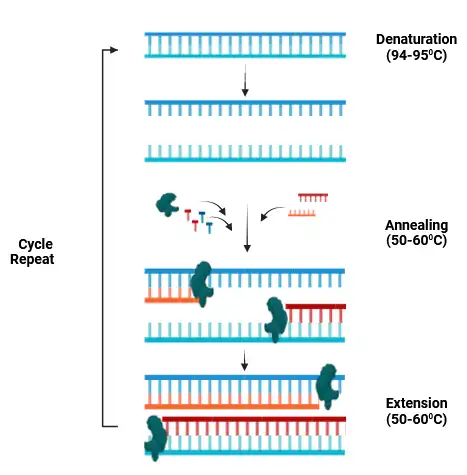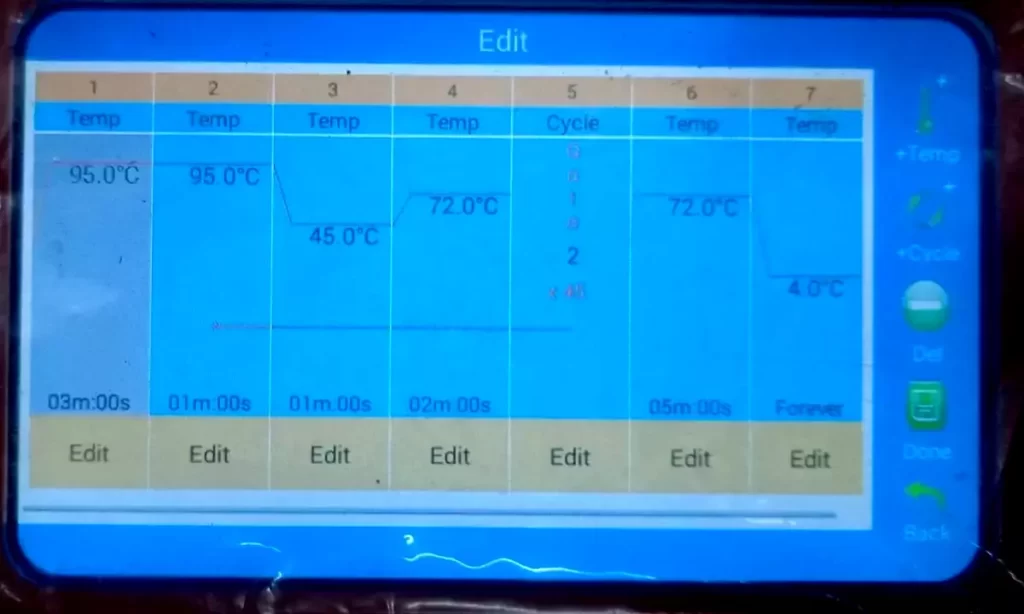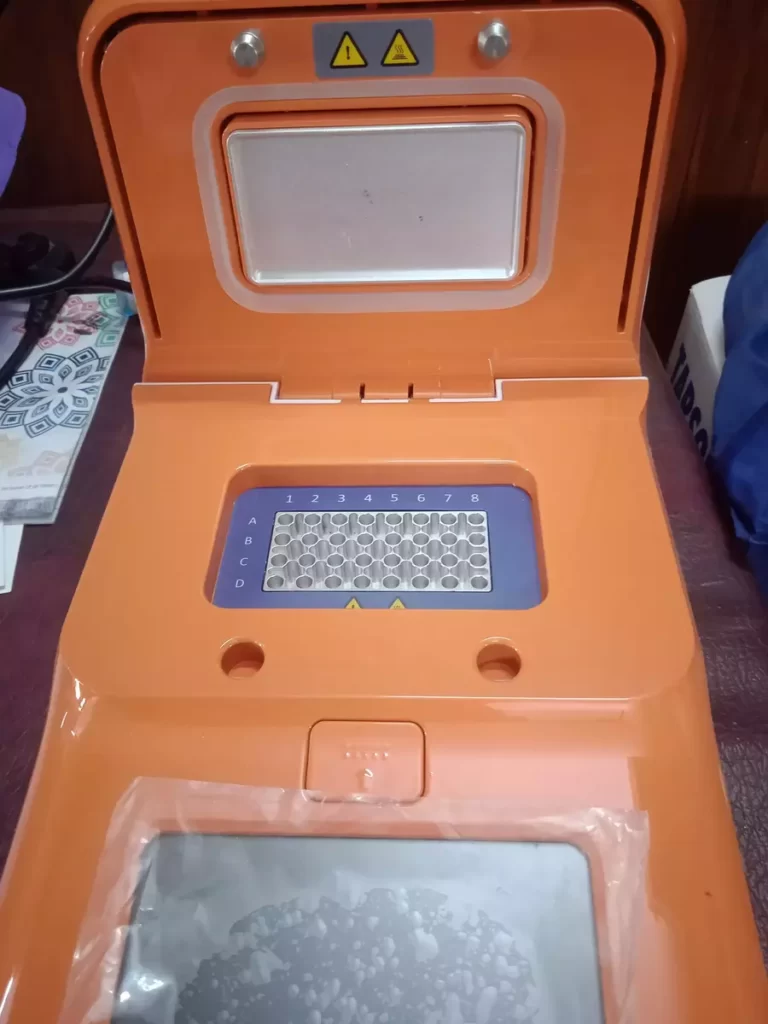Table of Contents
Definition | Introduction to Polymerase Chain Reaction (PCR)
Polymerase Chain Reaction is a method in molecular biology lab that uses polymerase, NTPs, and primers (Specific oligonucleotide) to make millions of copy of our desired nucleic acid in-vitro.
So why do we make such amount of nucleic acid copies (DNA copies) ?
Lets suppose that we have a case where we have only minute amount of sample (e.g. infected leaves or tissue etc.) of a disease. To perform required set of experiment (e.g. DNA fingerprinting, AFLP or RAPD) for identification of causing agent we need good amount of DNA. So, what do you think, are we able to perform the whole experiment with extracted DNA from sample,
Obviously, No! right. So in this case we will first amplify our sample DNA and then will conduct our experiment with amplified DNA.
Principal of PCR:
PCR uses a special ingredient called “DNA polymerase”, Nucleotide triphosphate (NTPs), a co-factors, primers and buffers. This ingredient is like a builder that helps create new DNA strands.
Its similar to the DNA replication but In PCR we do not use helicase to unwind DNA.
In PCR, By heating the DNA, separates the DNA and then by cooling primer anneal to complementary region of separated DNA which provide the docking place for polymerase enzyme.
Polymerase enzymes then uses NTPs( Appropriate mixture of ATPs, GTPs, CTPs, TTPs) extend the primers 3′ according to the template DNA (DNA separated) and eventually new strand of DNA get synthesized. these process repeats multiple times and the concentration of DNA get increase exponentially. Thus we can make millions of copies of a tiny bit of it.

this image is created with biorender
Who invented PCR technique| History:
Long ago in the 1980s, a smart scientist named Kary Mullis invented PCR. It was like discovering a treasure chest because scientists could finally copy DNA easily and quickly.
Requirements for PCR Components and fucntion:
Now it is the time to know the material required for the PCR and function of PCR components or PCR ingredients
- A small amount of DNA to copy
- Special DNA building blocks-NTPs (we call them nucleotides)
- DNA primers (like helpers to start copying).
- DNA polymerase (our builder) : An enzyme which synthesis new strands of DNA by adding nucleotide on primes 3′ side on DNA primer hybrid.
- PCR machine or thermal cycler, A machine that can heat and cool
- PCR Buffer – that make optimal medium where our reaction occur.
- PCR tubes– will contain our reaction mixture.
- Micro-pipette – required to measure accurately and transfer of enzymes, buffers etc. for preparation of reaction mixture.
- A clean working chamber/Area : to avoid contamination and hinderance in PCR.
- Nuclease free water : required for dilution of stock reagent and to make-up desired volume in reaction mixture. Nuclease free water is also used for working stock preparation primer, enzymes used etc.
- Centrifuge
- Mineral oil – Used to avoid or reduce evaporation of PCR mixture while in running (optional or when required).
Steps of PCR
Now we know all the required Material for PCR, then what are the steps of PCR or How to do PCR and how to program PCR machine.
There are three steps of PCR, Denaturation, Annealing and Extension.
- Denaturation (Heat Up): The DNA template is heated to around 94-98°C, causing its double-stranded structure to unwind and separate into two single strands.
- Annealing(Cool Down): The reaction is cooled to a temperature of 50-65°C, allowing short DNA primers to attach (anneal) to the single-stranded DNA at specific target sites.
- Extension (Elongation)/ (Copy Time): The temperature is raised to 72°C, the optimal range for the heat-resistant DNA polymerase to synthesize a new DNA strand complementary to the template strand.
Program setup on PCR thermal cycler
We know that there are three steps in PCR But there is little adjustment, As we know when we extract DNA, it is very large and the separation takes more time ( see below in the image).
After separation and remaining two steps it make 1st copy of DNA segment (between two primer) which sort than the original.
These sort fragment than require comparatively short time then the previous, that’s why we set initial denaturation steps in PCR program setup for longer time and then further add the above three steps for desired round.
After cycle complete a final synthesis steps of 5 min(mostly) were given to complete the remaining synthesis and the whole product were finally cool down for safety of our product.

Types of PCR
based on modification of ingredient/step of PCR can be of different type some are as –
- Real-Time PCR (quantitative PCR or qPCR)
- Reverse-Transcriptase (RT-PCR)
- Multiplex PCR
- Nested PCR
- High-fidelity PCR
- Fast PCR
- Hot-start PCR
- GC-rich PCR
- Long-range PCR
- Arbitrarily primed polymerase chain reaction (AP-PCR)

Procedure:
- We start by heating the DNA to make it split into two single strands.
- Then, we cool it down a bit, and the DNA primers stick to the single strands.
- DNA polymerase, starts making new DNA strands using the single strands as a template.
- Repeat: We do these steps again and again, making more and more copies of the DNA.
Applications:
PCR helps scientists in many cool ways:
- Genetic Research: PCR is a cornerstone of genetic studies, enabling the analysis of specific genes, mutations, and variations that underlie inherited disorders.
- Forensics: In crime scene investigations, PCR can amplify tiny amounts of DNA, facilitating the identification of individuals from minute biological samples.
- Medical Diagnostics: PCR plays a pivotal role in diagnosing infectious diseases by detecting the DNA of pathogens in patient samples.
- DNA Profiling: PCR-based DNA fingerprinting is used for establishing relationships, identifying individuals, and even determining paternity.
- Environmental Studies: PCR aids in studying microbial communities in diverse environments, shedding light on ecosystems and biodiversity.
Advantages:
- Super fast DNA copying
- Needs only a tiny bit of DNA
- Helps us understand genes and health
Limitations:
- Can make mistakes sometimes
- Need to know the specific DNA sequence to copy
Precautions:
- Keep everything clean to avoid mixing up DNA
- Use protective gear to stay safe while working with chemicals
Read also
FAQ
What is Polymerase Chain Reaction (PCR)?
PCR is a technique that allows rapid synthesis of a specific segment of DNA, making many identical copies for analysis and research purposes.
How does PCR work?
PCR uses a special enzyme called DNA polymerase, primers, nucleotides and buffers to repeatedly heat and cool the DNA sample. This process helps create multiple copies of the targeted DNA segment.
Who invented PCR?
PCR was invented by Kary Mullis in the 1980s.
What are the requirements for PCR?
To perform PCR, you need a DNA sample, DNA building blocks (nucleotides), DNA primers, DNA polymerase, and a thermal cycler that can control temperature changes.
What is the purpose of DNA primers in PCR?
DNA primers are short DNA sequences that guide DNA polymerase to start copying the targeted DNA segment.
Can PCR be used for detecting diseases?
Yes, PCR is widely used for detecting infections like flu and COVID-19 by identifying specific DNA or RNA signatures of pathogens.
What are the advantages of PCR?
PCR offers fast DNA copying, requires a small amount of DNA, and is crucial for genetic research and disease diagnosis.
What are the limitations of PCR?
PCR requires knowledge of the DNA sequence, and sometimes errors can occur during the copying process.
How does real-time PCR differ from traditional PCR?
Real-time PCR is also a form of PCR allows scientists to monitor the DNA copying process in real-time, but in traditional PCR one need to see result in detectors.
What precautions should be taken during PCR?
Precautions include maintaining a clean workspace, using protective gear, and avoiding contamination to ensure accurate results.
